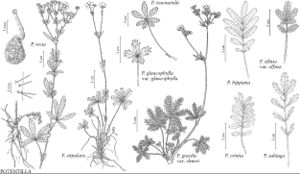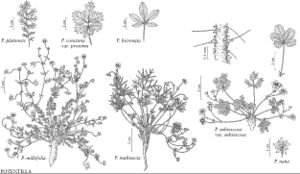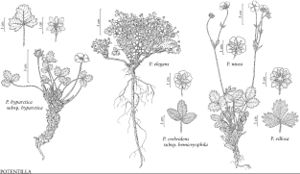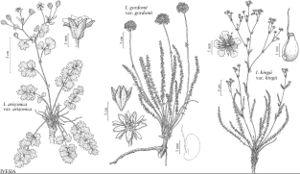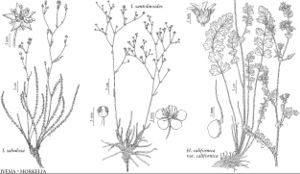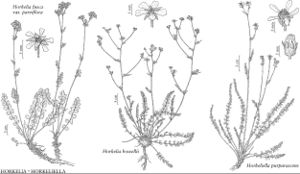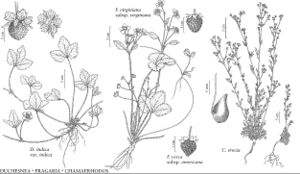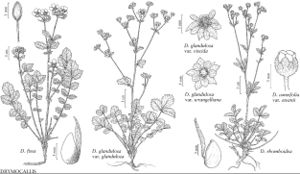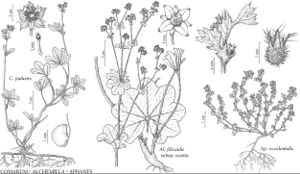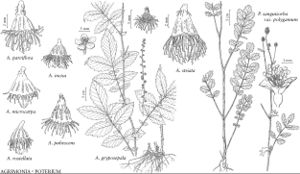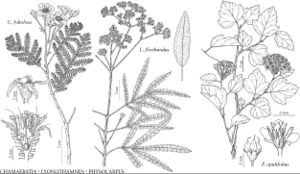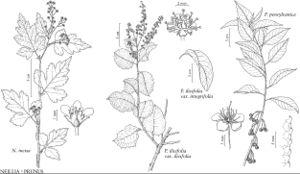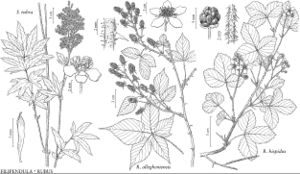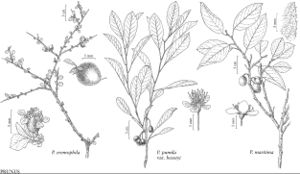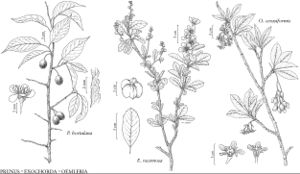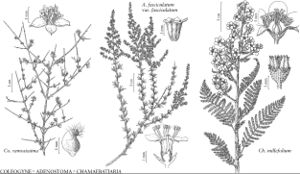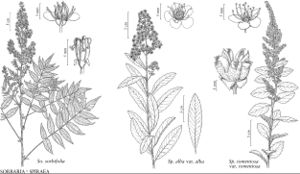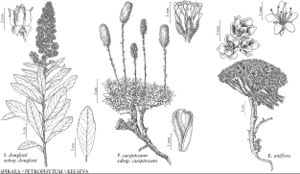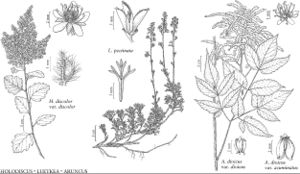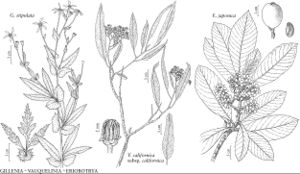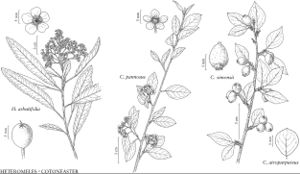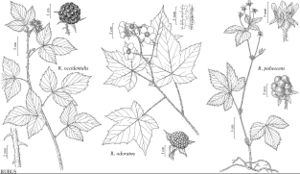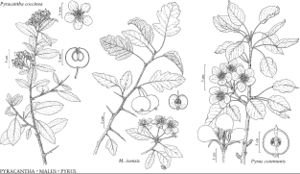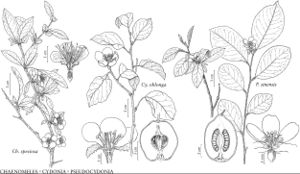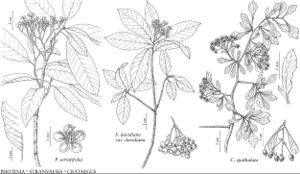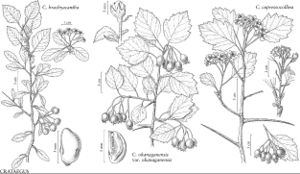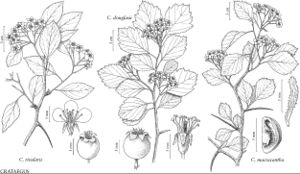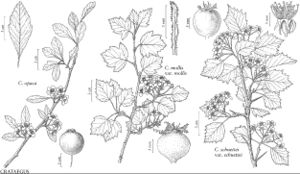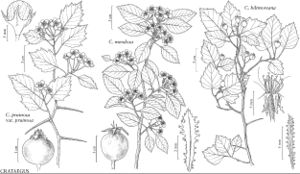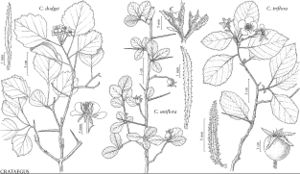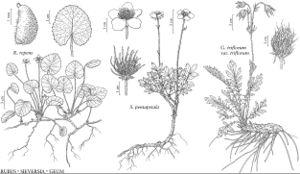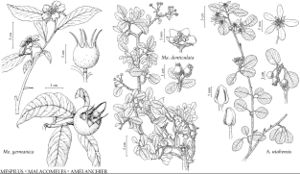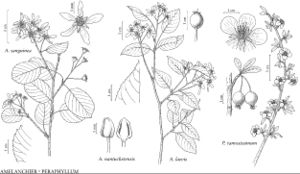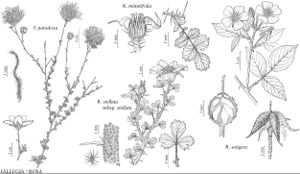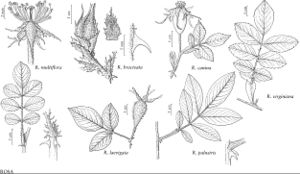Rosaceae
Herbs (annual or perennial), shrubs, or trees. Stems simple or branched. Leaves persistent or deciduous, basal and/or cauline, usually alternate, rarely opposite, simple or compound (palmate or imparipinnate); stipules usually present, sometimes absent; petiole present or absent; blade thin to coriaceous, margins ± lobed or unlobed, usually toothed. Inflorescences terminal, sometimes axillary, panicles with terminal flower (that, determinate) or reductions of this: 1-flowered, glomerules, fascicles, spikes, racemes, corymbs, umbels, or cymes. Flowers usually bisexual, rarely unisexual, perianth and androecium perigynous or epigynous; epicalyx bractlet sometimes present; hypanthium flat to hemispheric, or cylindric to funnelform or urceolate; sepals (0–) 4 or 5 (–10), distinct, free; petals (0–) 4 or 5 (–12, rarely more in double ornamentals), distinct, free; nectar disc sometimes absent; stamens 0–130 (–220), distinct, free, anthers usually longitudinally dehiscent; torus well developed, inconspicuous, or absent; pistils 1–250 (–450), distinct or ± connate, free or ± adnate to hypanthium, ovary superior or inferior (then 2–5-carpellate and locular and ± connate with axile placentation), styles terminal, subterminal, lateral, or ± basal, sometimes basally connate, stigmas usually capitate; ovules 1 or 2 (–5+), basal, marginal, or apical, collateral, superposed, biseriate, or clustered, integuments 2, crassinucellate, with or without obturator. Fruits achenes aggregated or not, follicles aggregated or not, drupes aggregated or not, aggregated nutlets, pomes, aggregated drupelets, or capsules; sometimes involving accessory organs, for example, hypanthium, torus. Seeds 1 or 2 (–12+), not arillate.
Contents
Distribution
North America, Mexico, West Indies, Bermuda, Central America, South America, Eurasia, Africa, Atlantic Islands, Indian Ocean Islands, Pacific Islands (Hawaii), Pacific Islands (New Zealand), Australia
Discussion
Genera 88, species ca. 3000 (68 genera, 680 species, including 22 hybrids, in the flora).
Three subfamilies and 16 tribes are recognized for the family with representatives of all tribes found in the flora area.
Rosaceae grow most commonly in north-temperate regions and are more or less absent from hot deserts and high-rainfall, low-altitude tropics. The family is large and diverse, characterized by radially symmetric flowers with a fundamentally saucer-shaped hypanthium and peripheral calyx, corolla, androecium, and, usually, superior gynoecium. Considerable variation occurs in important details of flower and fruit, this enhanced by a very adaptable hypanthium, which is discussed in more detail below.
Rosaceous inflorescences vary in the number of flowers from one to about 500. A great variation occurs also in inflorescence form, though a pattern is perceived when they are viewed as reduction series from a terminal, determinate panicle that is fundamentally bracteate, thus generating a range of panicles, racemes, corymbs, cymes, solitary flowers, or other forms. In this treatment, appendages on the inflorescence are distinguished by the terms bract and bracteole. Bract is used for the larger, laminate, usually chlorophyllous leaf homologues that subtend axes and may be indistinguishable from foliage leaves. Bracteoles are scalelike, often membranous, often caducous, and of uncertain homology, in part due to not being restricted to axis-subtending positions.
The floral architecture in Rosaceae is radially symmetric around a disc-shaped to urceolate hypanthium. Flowers normally have a four- or five-merous corolla and calyx; great variation is found in the numbers of stamens and carpels. Pollination is usually entomophilous, the flowers having normally green sepals and showy, often more or less clawed, usually white, yellow, or pink, less commonly red or green, petals. The flowers in some genera are relatively small and anemophilous and may lack one or two of the principal whorls. An unusual feature of some rosaceous flowers is the torus, a pad of receptacular, usually spongy, tissue, sometimes relatively large, in the center of the hypanthium that, when present, bears the gynoecium. Another unusual feature of some genera is an epicalyx that comprises a ring of sepaloid bractlets, usually of the same number as sepals, which is located on the hypanthium proximal to the calyx.
Fruit types are particularly significant both in rosaceous identification, taxonomy, and diversity, as well as for successful dispersal. Fruit in Rosaceae may be either dry, then dehiscent or not, or succulent and indehiscent; it sometimes involves accessory organs such as the torus or a persistent hypanthium.
Dry indehiscent fruits are achenaceous, in certain cases involving modifications to the style. In anemochorous (adapted for dispersal by wind) situations, this may involve a plumose style, for example, Cercocarpus; in epizoochorous (distributed on the outside of animals) cases, the styles may bear stiff hairs or barbs, for example, Geum. Alternatively, achenaceous fruits may lack styles (sometimes due to abscission) or, more commonly, have a relatively short one, for example, Potentilla. In situations where there appears to be no significant post-flowering function for the style, dispersal may be myrmecochorous (by ants), anemochorous, or in the rare torus-borne cases (for example, Fragaria), the fruit may be endozoochorous (eaten by animals and passed through the gut). Sometimes, fruits with such styles are aggregated in acheneta that rely on barbed, persistent hypanthia for epizoochorous dispersion, for example, Acaena and Agrimonia. Dry dehiscent fruits are follicular with seeds normally distributed by air after splitting of the ripe follicle, for example, Gillenia.
Succulent, endozoochorous fruits exhibit a similar range of variation. The most common types are: multiple drupelets on the surface of a more or less conic torus (for example, Rubus); individual and sometimes large drupes on a flat receptacular apex (Prunus); pomes, which are berrylike fruits in which a fleshy hypanthium more or less completely surrounds and is generally more or less fully adnate to the carpels (for example, Amelanchier, Crataegus). The result is that a terminal orifice may remain open, often bearing floral remnants around its rim. Pomes with hard pyrenes are sometimes distinguished as polypyrenous drupes, a term not used in this treatment due to antonymic confusion caused by combining the roots for pyrene (hardened mesocarp) and drupe (fleshy mesocarp), although the relevant distinction is well recognized (J. Rohrer et al. 1991).
Some important temperate fruits are members of the Rosaceae: apples (Malus), pears (Pyrus), almonds, apricots, cherries, peaches, and plums (Prunus), blackberries and raspberries (Rubus), strawberries (Fragaria), loquat (Eriobotrya); minor fruits include those of Amelanchier, Crataegus, Cydonia, Mespilus, and others. Some genera are popular in ornamental horticulture in North America, for example, most of the above as well as, especially, Chaenomeles, Cotoneaster, Pyracantha, Rhaphiolepis Lindley, Sorbus, Photinia, Physocarpus, Rosa, and Spiraea among trees and shrubs; and Filipendula, Geum, Potentilla, and Spiraea among plants suitable for flower borders.
Apomixis is a feature of some rosaceous genera and may make taxonomic decisions difficult or equivocal in genera such as Alchemilla, Amelanchier, Crataegus, Rubus, and others. Apomixis always seems to be associated with polyploidy and often with hybridization; in some apomictic genera, sexual species and apomicts are facultatively sexual.
Rosaceae lack alkaloids and blue anthocyanic pigments. Some have foliage or seed that becomes toxic due to hydrolysis of benzaldehyde cyanohydrins.
The great diversity of Rosaceae reflects the age of the family (since at least the mid Eocene) and its evolutionary success. The family has needed no fundamental change in circumscription since Jussieu first recognized it, the sometimes included outgroups, for example, Chrysobalanaceae, Neuradaceae, already being confidently excluded in more recent pre-molecular classifications, while segregate families (for example, Malaceae) have received little currency. This reflects a lack both of close neighbors and of large internal discontinuities. Species limits are often debatable, especially where apomixis is present; generic limits are much more fixed, apart from the familiar historic trend to recognizing smaller, more discrete units. What has principally been fluid in rosaceous taxonomy until modern molecular research are the phylogenetic relationships, both to neighboring families and within the family. Rosales once contained families such as Crassulaceae and Saxifragaceae, which have many morphological similarities to Rosaceae, but Angiosperm Phylogeny Group (2003) indicated instead that in Rosales, Rosaceae is sister to a group of families including Moraceae, Rhamnaceae, Ulmaceae, and Urticaceae.
The internal relationships of Rosaceae have received much study, including morphological, anatomical, cytological, phytochemical, breeding system, fungal pathogenicity (especially rusts), and molecular. Among these studies, that of D. Potter et al. (2007) resulted in the first comprehensive molecular phylogeny of Rosaceae, and the treatment in this volume reflects it. Potter et al. recognized three subfamilies with 15 tribes worldwide. Their classification used the ranks supertribe and subtribe, not used here. The subfam. Dryadoideae, with one tribe and four genera, diverged early and is unique in Rosaceae for its actinorhizal symbiosis; it has achenaceous fruits. Subfamily Rosoideae has six tribes and 29 genera and is only slightly altered from its traditional circumscription by shedding Dryadoideae and three small genera. Most Rosoideae have achenaceous fruit; some have multiple drupelets or achenes borne on a torus. The remainders of Rosaceae are found in the large and heterogeneous subfam. Amygdaloideae of nine tribes and 54 genera. This subfamily has the largest diversity of fruit types. Amygdaloideae now contains the traditional spiraeoid genera with follicular fruit, Maleae with pome fruit, and Amygdaleae with drupaceous fruit.
Key to Subfamilies and Tribes of Rosaceae
Selected References
None.
Illustrations
Key
Key to Subfamilies and Tribes of Rosaceae (Luc Brouillet)
| 1 | Leaves simple, sometimes pinnately, rarely palmately compound, stipules deciduous or absent, rarely persistent, if pinnately compound and stipules persistent, then fruits follicles (rarely achenes); flowers: perianth and androecium perigynous or epigynous, tori absent or minute; ovules 2+ (rarely 1, sometimes by abortion); fruits usually aggregated follicles or drupes or nutlets, pomes, ± woody capsules, follicles, or drupes, rarely achenes [c. Rosaceae subfam. Amygdaloideae, p. xxx] | > 2 |
| 1 | Leaves pinnately, sometimes palmately, compound, sometimes simple, stipules persistent and adnate to petioles, sometimes deciduous and free, rarely absent; flowers: perianth and androecium perigynous, tori enlarged, sometimes small or absent; ovules 1(or 2, then fruits achenes or drupes); fruits achenes, or aggregated drupelets or achenes (within fleshy, urn-shaped hypanthia [hips] in Roseae) | > 10 |
| 2 | Leaves opposite; carpels 2(or 3), distinct, free; fruits aggregated follicles | Lyonothamneae |
| 2 | Leaves alternate, rarely opposite; carpels 1–8, distinct or connate, free or ± adnate to hypanthium; fruits achenes, drupes, aggregated achenes, drupes, nutlets, or follicles, or capsules or pomes | > 3 |
| 3 | Shrubs or herbs; stipules present; leaves pinnately compound, rarely simple | > 4 |
| 3 | Trees or shrubs, rarely herbs (then stipules absent); stipules present or absent; leaves simple, rarely pinnately compound (then herbs or trees) | > 5 |
| 4 | Shrubs; carpels 1–5, basally connate or distinct | Sorbarieae |
| 4 | Herbs; carpels 5, basally connate | Gillenieae |
| 5 | Carpels 1; fruits drupes | Amygdaleae |
| 5 | Carpels 1–5; fruits achenes, aggregated drupes, aggregated nutlets, aggregated follicles, capsules, or pomes | > 6 |
| 6 | Flowers: perianth and androecium epigynous (perigynous in Vauquelinia); carpels ± connate or distinct, adnate to hypanthium (free in Vauquelinia); fruits pomes or woody capsules (surrounded by persistent hypanthia and splitting into 5 follicles Vauquelinia) | Maleae |
| 6 | Flowers: perianth and androecium perigynous; carpels distinct, sometimes ± connate, free or rarely adnate to hypanthium base; fruits achenes, aggregated follicles, aggregated nutlets, aggregated drupes, or capsules splitting into 5 follicles (not surrounded by hypanthia) | > 7 |
| 7 | Shrubs; leaf venation palmate (stipules present); carpels basally connate | Neillieae |
| 7 | Shrubs, sometimes subshrubs, trees, or herbs; leaf venation pinnate (sometimes palmate in Spiraeeae, then stipules absent); carpels distinct (sometimes connate in Exochordeae) | > 8 |
| 8 | Fruits capsules or aggregated drupes | Exochordeae |
| 8 | Fruits aggregated follicles or nutlets, or achenes | > 9 |
| 9 | Shrubs; stipules persistent or deciduous; leaves alternate or opposite; carpels 2–8 or 1 (in Coleogyne); ovules 1 or 2, marginal; fruits achenes or aggregated nutlets | Kerrieae |
| 9 | Shrubs, subshrubs, or herbs; stipules absent; leaves alternate; carpels 3–5(or 6); ovules 2–5, apical; fruits aggregated follicles or achenes (in Holodiscus) | Spiraeeae |
| 10 | Shrubs or trees, unarmed; leaves simple, sometimes pinnately compound; styles persistent, elongate in fruit [b. Rosaceae subfam. Dryadoideae] | Dryadeae |
| 10 | Herbs, shrubs, or subshrubs, these sometimes armed; leaves pinnately or palmately compound, rarely simple; styles deciduous, if persistent in fruit, then either not elongate, or rarely elongate (in Colurieae) [a. Rosaceae subfam. Rosoideae] | > 11 |
| 11 | Shrubs or subshrubs | > 12 |
| 11 | Herbs | > 15 |
| 12 | Hypanthia ovoid, oblong, globose to cupulate or urceolate, rarely obovoid or hemispheric, tori absent (conic if present); fruits aggregated achenes within hypanthium (hips) | Roseae |
| 12 | Hypanthia saucer-, cup-, or funnel-shaped, hemsipheric to flat, or obconic to obcampanulate, tori enlarged; fruits achenes, or aggregated achenes or drupelets | > 13 |
| 13 | Plants armed, sometimes unarmed; stipules free or adnate to petiole base; fruits aggregated drupelets… | Rubeae |
| 13 | Plants unarmed; stipules absent or ± free or ± adnate to petiole; fruits aggregated achenes, sometimes achenes | > 14 |
| 14 | Epicalyx bractlets absent, sometimes present; styles terminal, sometimes subterminal, elongate in fruit | Colurieae |
| 14 | Epicalyx bractlets present, sometimes absent; styles basal or lateral to subterminal, not elongate in fruit | Potentilleae |
| 15 | Leaves pinnately compound, sometimes simple with palmate venation; stipules free; fruits aggregated drupelets; ovules 2, collateral | Rubeae |
| 15 | Leaves pinnately or palmately compound, rarely simple with pinnate or palmate venation; stipules adnate to petiole, sometimes free; fruits achenes or aggregated achenes; ovules 1, if 2 then superposed | > 16 |
| 16 | Tori inconspicuous or absent, sometimes enlarged in fruit; carpels 1–12 | > 17 |
| 16 | Tori usually enlarged; carpels 1–260(–450) | > 18 |
| 17 | Ovules 2; fruits aggregated achenes, not enveloped by hypanthia; tori enlarged in fruit | Ulmarieae |
| 17 | Ovules 1; fruits achenes, enclosed within enlarged, often hardened, hypanthia; tori not enlarged in fruit | Agrimonieae |
| 18 | Epicalyx bractlets absent, sometimes present; styles terminal, sometimes subterminal, elongate in fruit | Colurieae |
| 18 | Epicalyx bractlets present, sometimes absent; styles basal or lateral to subterminal, not elongate in fruit | Potentilleae |
"thin" is not a number.




